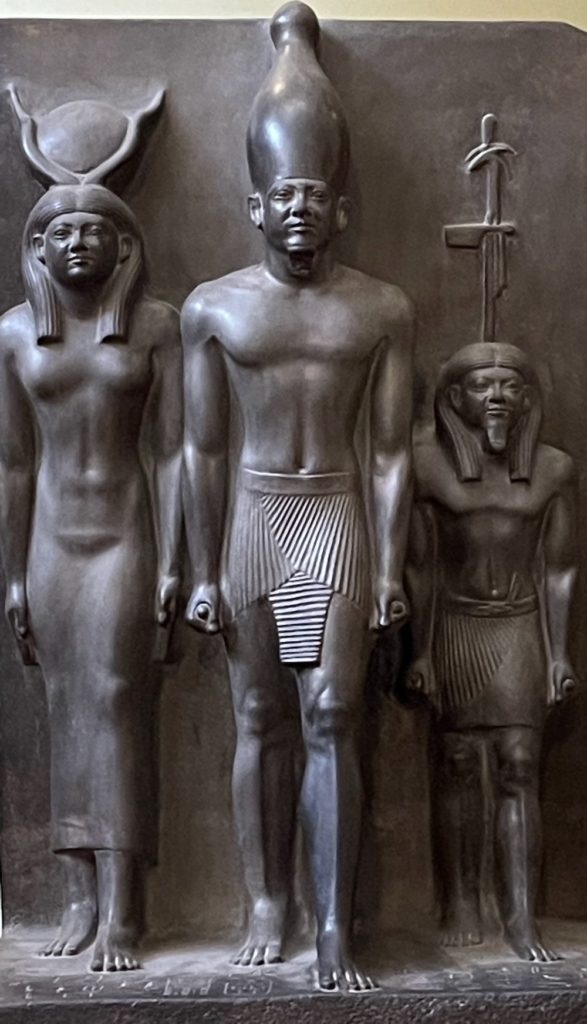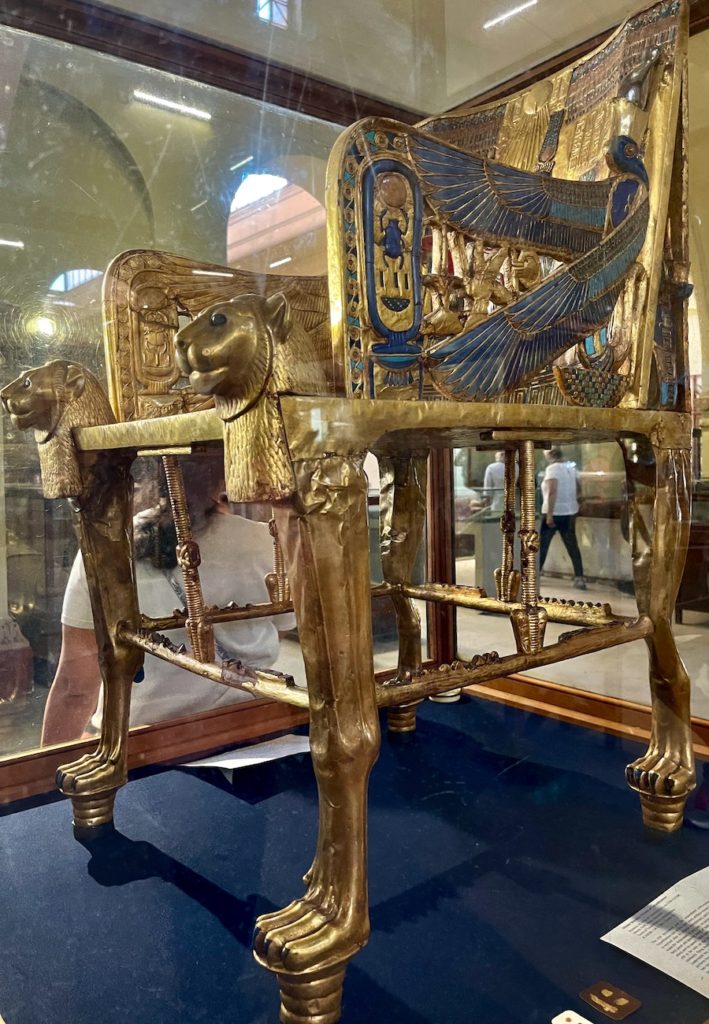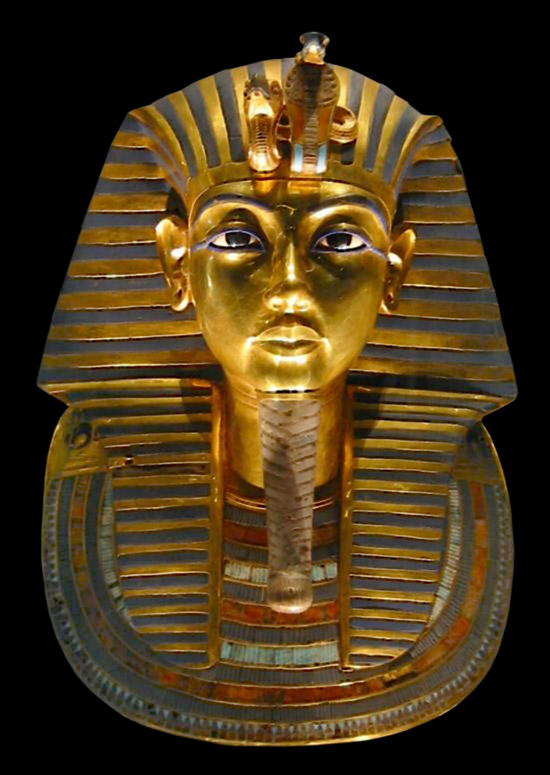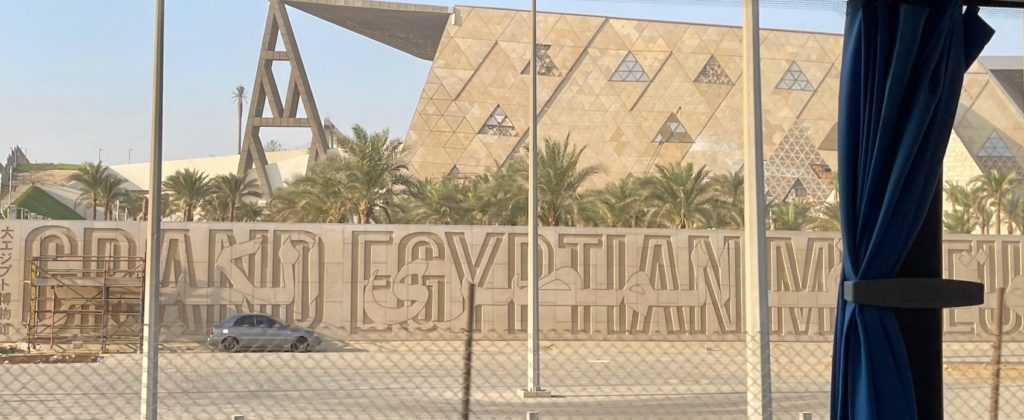
Ancient Egypt: Mummies On the Move and Museums In Transition

Many Egyptian wanna-be visitors wonder: Should we wait until the spectacular, state-of-the-art Grand Egyptian Museum finally opens, or is Egypt worth visiting now, when the current showcase for Egypt’s treasures, Cairo’s Egyptian Museum of Antiquities, is half-empty?

Advice after our visit to the old museum: GO NOW. It’s true that the dusty place is packing up with movers bustling about, doing what movers do. We saw stone panels saran-wrapped and stacked in hallways, piles of taped-up boxes filled with ancient art, smudgy glass cases empty and unlocked, their former treasures removed.
But this museum, even half empty, has oodles of wonders, and two hours to see it all? Not near enough time, because what’s left behind is still just one big ‘WOW’.

After entering the crowded main museum hall, we stared up to see four towering God Kings staring back down at us. Quite judgy-looking, these God Kings. (…probably thinking: “more tourist riff raff? What’s with all the phones, people? Do you have to take a picture of every statue? Did you notice that this place has skylights, so all your pics will suck?’)

Pharaoh King Ramses II is up there looking down, of course, because everywhere we turn in Egypt there’s another enormous statue of this guy. Size and fame mattered to Ramses, obviously, and he was quite the skilled social influencer. But instead of begging for likes on Instagram, he did it with massive statues.
Ramses II ruled Egypt for 66 years, from 1279 BC to 1213 BC, and during that time he plastered his image all over Egypt. Couldn’t get away from the guy; still can’t.

Ah, but time and history have worked over this arrogant autocrat, as time and history tend to do. Today Ramses is also known as Ozymandias, king of the famous 1818 Percy Bysshe Shelley’s sonnet, an autocrat-dissing ode to a trashed ancient statue. Shelley is probably referring to our guy Ramses II, since the British Museum had just acquired parts of his broken statue when he wrote that mocking line: “Look on my works, ye Mighty, and despair!”
We are also going to visit Ramses’ Abu Simbal temple complex, which he built to terrorize any Nubian who dared cross Egypt’s southern border. His Abu Simbal statues lay buried up to their necks in desert sand for thousands of years. So take that Mr. Ramses. So much for fearing YOU, I thought, as I snapped a shot and walked on by.




In what reminded me of my elementary school’s dark old hallways, we passed by imposing stone sphinxes, more (always more) pharaoh statues, and elaborately carved and painted sarcophagi (and yes, we probably took photos of most of them).



So plenty to see here. And there are crocodile mummies! How cool is that? So don’t miss the Animal Mummy Room, where dusty dead critters abound (hey, they’re dead. They should be dusty). Before the emptying out, people said the old museum reminded them of a crammed-full cluttered Gramma’s attic. Now it’s more like a cluttered pantry, with room to breathe, so it’s a great time to visit.


KING TUT DELIVERS THE BLING




Even though King Tut was a minor king, historically, the modern world adores all things Tut since his tomb was one of only a few robbers didn’t ransack. Just outside the Tut Room, we stared at exquisite alabaster Canopic innards jars, Tut’s spectacular gold and gem-encrusted chair, his black jackal (my fave), and one of his enormous, gold-on-gold sarcophagus containers. And all those artifacts were in or just off the hallway, in alcoves.

‘Wonderful things’ everywhere we turned, as Howard Carter said in 1922, when he first gazed in a tiny hole at the glittering stash. And we weren’t even in the Tut Treasure Room yet.

And oh, the Tut Room! 43 years ago, I gasped when I saw some of the Seattle traveling exhibit Tut treasures, and it was no different this time. I circled back three times to stand in front of his solid gold mask and just stare at it. I swear it was glowing at me, right at me.
And Padre finally saw the Tut treasures, as well as the honest-to-God mummified man himself (coming up, in the Valley of the Kings). In 1978 he stood in a Chicago line for hours with three toddlers in tow, but the exhibit closed just as he reached the head of the line. He’s been telling me this story for years, and I’m thrilled that he finally has his happy ending. (and I don’t have to hear the story anymore, maybe?) This time, he did plenty of mouth-hanging-open-staring just as I did.
And so my dream to view the rest of Tut’s treasures in person, in Egypt, finally came true (story, here). I found it almost impossible to walk away, since at our ripened age the odds we will return are eh probably not. Yet we are both just so thankful we lived long enough to make it.
But of course there was more, so much more, to see.

Wood figure with white quartz and resin eyes, Fifth Dynasty, depicting a khry-heb, or lector priest, named Ka-aper. 
Montuhotep II, first ruler of the Middle Kingdom period. He is shown with black skin (representing fertility and rebirth) and the red crown of Lower Egypt. 
Queen Hatshepsut’s head, originally found decorating her mortuary temple. 
King Akenaton introduced monotheism and an elongated form of sculpture to Egypt. Did not go well! He succeeded historically, though, because he fathered King Tut. 
Unfinished bust of Nefertiti, queen of New Kingdom rebel king Akenaton. The name Nefertiti means “the Beautiful One Is Here.” 
Hippo sculptures were placed in tombs due to Egyptians’ love of hunting, and also represented chaos. The hunt for hippos served as a metaphor for how Egyptian pharaohs could conquer evil. 
River imagery abounds on ancient artifacts, since the Nile’s flora and fauna proved essential to the existence of ancient Egyptian civilization. 
Sacred Cow and Chapel of the Goddess Hathor, 18th dynasty 
This giant hawk is actually hollow, and once contained raptor mummies.
MUMMIES ON THE MOVE
The Museum’s popular Mummy Gallery section emptied out last spring, so we missed ‘em this time. I hear that the mummies are the stuff of terrifying nightmares due to the gruesomeness factor. (Real dead people here! Hapshupsut was so obese! She had horrible teeth, and needed a good dentist! Is that her real hair?)

Those still seeking the nightmares can travel a few miles across town to the newly opened National Museum of Egyptian Civilization (we didn’t have time), where the mummies moved last April, in a lavish Golden Parade of the Pharaohs.

This particular group of mummies – 18 pharaohs and four queens – have NOT been allowed much rest in the afterlife. First, they were mummified thousands of years ago, placed in fancy tombs and secreted away, to rest forever after their successful afterlife journey.
Crafty tomb robbers disturbed their slumber holes within a few hundred years or so, stripping the tombs bare of anything that could be carried out, sometimes ripping mummies to shreds in search of gems, jewelry, and gold layered within the linens. And funny how the robbers were seldom stumped in terms of where to find the good stuff. Many experts suspect the thieves were the guys who built the tombs; they would know where to look, now, wouldn’t they?
To foil the persistent robbers, someone stashed the famous pharaohs in a couple piles (pretty much) high up in obscure Valley of the Kings tombs. This hiding plan worked well for centuries, until modern archeologists started digging. Those guys (it was almost always guys) found the first stash of mummies in 1881, the second in 1898, and set off an Egyptology craze that continues to this day. When the Egyptian Museum of Antiquities opened in 1902, the mummies were moved yet AGAIN to the museum’s Mummy Galleries.
But this year they moved yet AGAIN. I imagine they’re getting quite tired of all this moving by now.
The dead dusty luminaries made their most recent cross-town journey accompanied by soaring orchestral music, military bands, and costumed, Liz Taylor/Richard Burton impersonator actors dancing down the street. The dead rode in tank-like vehicles equipped with shock absorbers, so the mummies’ ancient bones wouldn’t shatter to dust in the middle of the extravagant parade. So obviously those ancient old kings and queens can still draw a crowd, even though they had to take it all in from a stiff prone position.

Our most famous Egyptian mummy, King Tut, did not go along for the fancy ride. Early Egyptologists decided to leave Tut’s mummy in his original Valley of the Kings tomb instead of moving him to town, and he’s still there.That said, his resting place is not any more peaceful than a parade, especially when tourists such as ourselves stop by all the time and disturb his afterlife slumber with I-phones and excited tourist chatter. (I do feel bad about that, Tut. I sort of do.)

It is also true that some question the appropriateness of parading the dead through town (or posing for a snap with Tut’s real mummy). Not respectful of the dead at all, but the Egyptians, the British-French-Germans-Americans, the tomb robbers, the museum curators, and all those archeologists have never been shy about showing off the ancient dead, have they?
Egypt’s government is so proud of their mummies, in fact, that a tape of The Pharaoh’s Golden Parade played on a loop as our flight made its approach into the Cairo airport. As we sat captive in our seats, we viewed it several times because the government types understand, just as ancient tomb robbers did, that there’s money to be made when the contents of ancient tombs see the light of day.

The mummies rode their rides to the new Museum of Egyptian Civilization three miles away, but the rest of Tut’s treasure will move to the Grand Egyptian Museum once it’s completed – in a glitzy parade, no doubt. The Egyptian government has pushed back the opening several times; currently, it’s scheduled to open its doors Fall, 2022. Whether it will or not is anyone’s guess. Ousted Egyptian leader Hosni Mubarak laid the cornerstone back in 2002, so I wouldn’t hold my breath. When we drove by it, though, the site looked almost finished so we tourists can hope.
INDIANA JONES COULD WORK HERE!

Yet even after the dusty Tut room is empty, the old museum will be worth a visit. Restorations of the impressive, 1902 Beaux-Arts building are now underway, to help it better compete with the newcomers across town.

The old building will be dedicated not just to colossal statues of ancient kings and queens, but to the relics of everyday life. The Tanis royal treasures, which are considered as spectacular as Tut’s but less well known, will be featured – gold masks just as cool as Tut’s, jewelry, solid silver coffins, and artifacts that show how regular Egyptians who weren’t pharaohs lived and died. People like us.
DON’T MISS THE IMPORTANT PEOPLE IN THE GARDEN
For now, the old wood cabinets, winding staircases, and soaring skylight ceilings have Indiana Jones-inspired charms, and I can imagine famous old archeologists lurking around. Heck, there’s one guy, the French Egyptologist Auguste Mariette, who still DOES lurk around, in his very own stone sarcophagus outside in the garden.

Mariette’s tomb sits in the middle of an arc of busts depicting several other Egyptian archeological luminaries, including Champollion, who cracked the code of hieroglyphics.
Without Champollion, today we might look at the wild wall art on the walls of Ramses V’s tomb and think ‘nice color scheme!’ We’d be totally missing the fact that all those pretty pictures described crucial information from the Book of the Dead for Ramses V, info he absolutely HAD to have, if he hoped for a pleasant journey to the afterlife.


So we rested with the important dead guys as tourists snapped too many selfies in front of Mariette’s statue, and pigeons came in for landings on his head. I wonder how many of them knew who Mariette or Champollion were? Without those guys, many of Egypt’s most amazing antiquities would just be pretty statuary adorning some rich person’s poolside deck.
From what I’ve read about Mariette I think he’d enjoy this scene, since he dedicated his life to making the Egyptian Museum of Antiquities a place for all Egyptian people, and for the world, to enjoy.
And don’t forget the basement. Centuries of treasures have been stored and studied here. The studiers do need more room, better equipment, and a safer environment in which to work, all of which will be had in the new museum.
But there are treasures tucked away in drawers that haven’t seen the light of day for over 100 years. Once all three museums are up and running, curators will have plenty of space to display it all, and who knows what ‘wonderful things’ the curators might find down there in those old basement cupboards?
HOW Many Cairo Museums, Did You Say?
So count with me now: How many must-see museums will Cairo have by 2022? (ok, maybe 2023..)? There will be THREE Cairo museums you’ll definitely want to visit, for a comprehensive picture of Egypt’s ancient treasures.
Then, and only then, will you want to head off for your Nile River cruise to see temples, tombs in the Valley of the Kings (and Queens), and so much more.

Did I hear someone say ‘too much?’ Nope, never. At least not for us!
Next up: A Cairo local market, the bartering game, and what about those veils?
Thanks as always, everyone, for following along.


